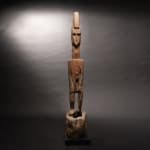Igbo Wooden Alusi Sculpture, 1800 BCE - 1900 CE
Wood
106.7 x 17.8 cm
42 x 7 in
42 x 7 in
PF.3989
Further images
-
(View a larger image of thumbnail 1
)

-
(View a larger image of thumbnail 2
)

-
(View a larger image of thumbnail 3
)

-
(View a larger image of thumbnail 4
)

-
(View a larger image of thumbnail 5
)

-
(View a larger image of thumbnail 6
)

-
(View a larger image of thumbnail 7
)

-
(View a larger image of thumbnail 8
)

-
(View a larger image of thumbnail 9
)

-
(View a larger image of thumbnail 10
)

Igbo (also spelled Ibo) means 'peoples of the bush,' a name given to them by the Yoruba because they live in thick forests. Through their history the Igbo have managed...
Igbo (also spelled Ibo) means "peoples of the bush," a name given to them by the Yoruba because they live in thick forests. Through their history the Igbo have managed to keep their culture intact, maintaining their own customs, language and religious beliefs. They believe in the existence of innumerable invisible gods associated with rivers, markets and founding ancestors. These ancestors are represented by remarkable statues that are kept in sanctuaries and in the rest houses of men known as M'bari. The statuary found in them is very special and highly revered. As with this beautiful statue of a male, the figures are large and often found in couples, occasionally accompanied by smaller figures. They constitute a sort of ideal family portrait - husband, wife, children - with their social rank depicted through scarification and other attributes.
This statue's proud stance and noble character immediately lets us know we are in the presence of someone important. His pose is a model of strength, beautifully symmetrical and graceful in its vertical lines. Quite abstract he is nevertheless very human in his expressive face, and in small details like the slight protuberance of the Adam's apple. On great occasions the statues were brought from the sanctuaries dressed in Igbo costumes for all the village to admire. In looking at this superb statue we can easily feel their joy and pride; and the wonder its appearance created in seeing an object of art that embodies qualities that are beyond this world.
This statue's proud stance and noble character immediately lets us know we are in the presence of someone important. His pose is a model of strength, beautifully symmetrical and graceful in its vertical lines. Quite abstract he is nevertheless very human in his expressive face, and in small details like the slight protuberance of the Adam's apple. On great occasions the statues were brought from the sanctuaries dressed in Igbo costumes for all the village to admire. In looking at this superb statue we can easily feel their joy and pride; and the wonder its appearance created in seeing an object of art that embodies qualities that are beyond this world.
Literature
V19









